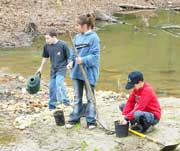 |
photos courtesy of Arlington Echo
Third graders from Bodkin Elementary plant native wetland species in a project to restore a troubled bog to help filter and slow stormwater rushing into Grey’s Creek. |
At Grey’s Creek, a Bog Once More
(An occasional series of first-hand accounts of saving the Bay)
On a grey, chilly Friday, May 6, 250 sixth graders and third graders streamed from buses along with teachers, parents and principals of Chesapeake Bay Middle School and Bodkin Elementary, both in Pasadena. Full of contagious energy, they grabbed shovels and started digging.
In their fresh holes, they planted pots of native sweet bay magnolia, low bush blueberry, swamp azalea, cinnamon fern and giant cane that waited with bags of peat moss along a half-mile of newly restored seepage wetland that links the crystal clear waters of North Grey’s Bog with Grey’s Creek. The students dug right in — literally — as they planted native flowers and shrubs laid out by Arlington Echo Outdoor Education Center coordinator Stephen Barry and staff.
The project — which brought together the Anne Arundel County Department of Public Works, the Sylvan View Community and Arlington Echo Outdoor Education Center — will restore a troubled bog to help filter and slow stormwater rushing into Grey’s Creek from a 142-acre drainage area. The day’s planting completed three years of work.
A healthy bog is a natural sandy wetland that filters runoff and makes a home for a variety of specialized plants, including carnivorous pitcher plants.
Bringing back this bog began when neighbor Judy Cole noticed trouble while surveying for Maryland Department of Environment.
“We were doing an aerial survey of Anne Arundel County bogs in 1999 and spotted the dredge spoil that had been dumped in this wetland when a marina was built in the ’70s,” she said.
Ron Bowen, director of Anne Arundel County Public Works, stepped in. “He has made this spectacular restoration project possible, giving the Mountain Road Peninsula its natural history back,” Cole said.
Cleaning out the bog was the first step to bringing it back.
Keith Underwood & Associates and BayLand Consultants removed about 4,000 cubic yards of spoils and uprooted phragmites, opportunist vegetation that had invaded when natives were overwhelmed. BayLand also brought sand from Grey’s Creek, plus native stone and gravel to create a graceful winding wetland system that draws the eye as well as runoff water.
“Keith has spent unlimited time hand-placing stones and re-creating the base for the bog,” says Sylvan View neighbor Pam Hicks.
“This is one of Anne Arundel County’s rare bog systems, whose capacity to filter pollutants from the water is unmatched,” Underwood explained of why he worked so hard. The new bog will slow water by directing flow through step pools.
Meanwhile, Arlington Echo’s Barry was working with students to bring the bog back to life.
There’s little money in the Anne Arundel County budget for such restoration projects. To fill that gap, The Anne Arundel Watershed Network is hard at work educating citizens and the county council about how we could create a Watershed Restoration Fund to finance the $80 million backlog of projects like this one. (Learn more at www.beinginplace.org.)
For now, The Arlington Echo school partnership stretches scarce funds as well as engaging hearts and hands.
Many of these students and their science teachers planted and nurtured seedlings to help restore the bog as part of Arlington Echo’s Chesapeake Connections, a hands-on environmental education and restoration program.
“Our students are raising Bay grasses, terrapins and yellow perch at school,” said Larry Zoller, a science teacher at Chesapeake Bay Middle School. Leaving school on trips like this, he added, lets kids “see first-hand the filtering capabilities and improved water quality they have helped to create. Each semester, we will monitor these plantings and the progress this restored area makes toward recovery.”
Seeing with their own eyes and doing with their own hands makes an impression on young minds. Chesapeake Bay Middle School seventh grader Amanda Ceraldi, paused from digging a hole for a cinnamon fern to say, “I learned how the bog helps the land not pollute the Bay.”
Added classmate Laura Volke, “It feels really good to be helping out the environment.”
Barry agreed. “This is the most rewarding part,” he said, “when you see the results of the work, the interest, the learning and the stewardship.”
